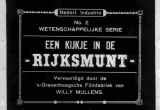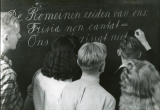NOF Films
An educational device
The NOF distributed its films mainly to primary schools (attended by children between six and twelve years of age) and what was known at the time as ‘continued’ or ‘extended’ primary schools (in most cases vocational schools for students with no academic aspirations). Most of the films that the NOF supplied were intended to be used as aids to the teaching of general school subjects. In addition, the institute also provided a small number of films on specialist topics.
The great majority of the NOF titles were meant to support lessons in geography and biology (or ‘natural history’, as it was called in the catalogues). History, languages and sports (gymnastics or swimming) were represented as well, but in smaller numbers. In addition, the NOF collection also contained a few films that were labelled as ‘civics’ (more often referred to in the English-speaking countries as ‘social guidance’), and that taught the children a desirable behaviour: road safety, for example, or personal hygiene.
Geography films
In the early years, films for geography lessons dealt primarily with ‘Dutch’ subjects. They documented the location, landscape and soil composition of specific cities or regions (Giethoorn, Zuiderzeepolders VI: na 10 jaren arbeid) or local economic activities (Giethoorn, Kaas, Zuiderzeepolders VI: na 10 jaren arbeid, Twentse textielindustrie). Later, when the NOF distributed also third party materials, its collection expanded and began to cover a geographically much wider area. Films about other countries and parts of the world often had an ethnographic slant: they showed not only the location of or economic activities in a particular region, but also addressed the customs and habits of its residents. Films on physical geography topics – about the operation of the universe, for example, or processes of erosion – made more intensive use of diagrams, and later also animations.
Biology illustrated
The NOF’s biology collection includes both botany films (In de bruine boon schuilt een plantenleven) and films for zoology teaching (De grote karekiet: nestbouw en broedverzorging). Most of these titles show the life cycle of plants and animals – from the early stages (the sowing and germination of seeds, or the laying and hatching of eggs) to growth and bloom (plants bearing fruits or young leaving their nests).
Historical film biographies
Some of the films the NOF produced revolved around a well-known Dutch personality. Antoni van Leeuwenhoek: een film over de ontwikkeling van de microscopie, for instance, shows Van Leeuwenhoek as the ‘inventor’ of the microscope, but also explains the role of microscopy in modern science and society. This film was considered suitable for both history and science teaching. As the staging of historical situations was a relatively expensive affair, films such as these were made in cooperation with other European countries. Partner organisations produced films about predetermined subjects and exchanged them with their neighbours free of charge.
More than just social guidance
In the 1940s and 1950s, Dutch children were rarely shown films that merely sought to teach them a certain behaviour – unlike their American peers for instance. The film Alle water is geen drinkwater informs its audience of the importance of clean drinking water to one’s personal hygiene, but it also deals with the technical aspects and course of the water purification process. In doing so, it both sketches a picture of an economic activity and establishes a (Dutch) civilisation ideal. De grote karekiet: nestbouw en broedverzorging sets its viewers a behavioural example (the boys in the central part of the film are remarkably respectful towards nature and its creatures) but is primarily about the life cycle of a particular species.
Writing Skills
Hansje en de Madurodammers, finally, is an example of a film that was supposed to be used in Dutch language teaching, more specifically in support of writing skills exercises. The film, which appears at first sight to be no more than a fantastic story, was meant to get its young audience to formulate their thoughts on paper. The second, longest part of the film has no spoken dialogue. This means that viewers had to determine themselves how to recount the events shown.
Note: All of the films mentioned here are part of the NOF collection at the Netherlands Institute for Sound and Vision (Nederlands Instituut voor Beeld en Geluid). For copyright reasons, only those titles that were produced by the NOF itself can be published on EYE’s website.
more information
If you are looking for more material from our collection, please contact Film Sales:
sales@eyefilm.nl
phone +31 (0)20 5891 426



